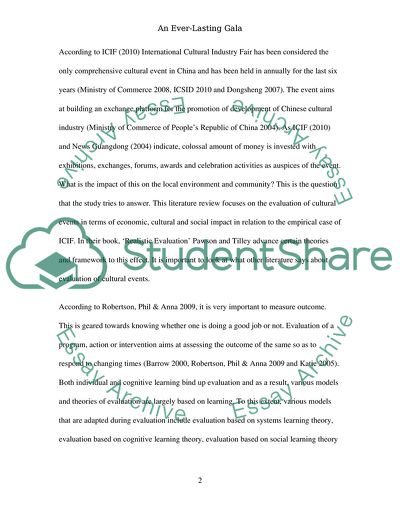Cite this document
(Uncovering the Cultural, Social and Economic Impact of Cultural Events Literature review, n.d.)
Uncovering the Cultural, Social and Economic Impact of Cultural Events Literature review. Retrieved from https://studentshare.org/culture/1741570-an-ever-lasting-gala-uncovering-the-cultural-social-and-economic-impact-of-comprehensive-cultural-events-on-the-local-environment-and-communitya-case-study-of-shenzhen-china-international-cultural-industry-fair-icif
Uncovering the Cultural, Social and Economic Impact of Cultural Events Literature review. Retrieved from https://studentshare.org/culture/1741570-an-ever-lasting-gala-uncovering-the-cultural-social-and-economic-impact-of-comprehensive-cultural-events-on-the-local-environment-and-communitya-case-study-of-shenzhen-china-international-cultural-industry-fair-icif
(Uncovering the Cultural, Social and Economic Impact of Cultural Events Literature Review)
Uncovering the Cultural, Social and Economic Impact of Cultural Events Literature Review. https://studentshare.org/culture/1741570-an-ever-lasting-gala-uncovering-the-cultural-social-and-economic-impact-of-comprehensive-cultural-events-on-the-local-environment-and-communitya-case-study-of-shenzhen-china-international-cultural-industry-fair-icif.
Uncovering the Cultural, Social and Economic Impact of Cultural Events Literature Review. https://studentshare.org/culture/1741570-an-ever-lasting-gala-uncovering-the-cultural-social-and-economic-impact-of-comprehensive-cultural-events-on-the-local-environment-and-communitya-case-study-of-shenzhen-china-international-cultural-industry-fair-icif.
“Uncovering the Cultural, Social and Economic Impact of Cultural Events Literature Review”. https://studentshare.org/culture/1741570-an-ever-lasting-gala-uncovering-the-cultural-social-and-economic-impact-of-comprehensive-cultural-events-on-the-local-environment-and-communitya-case-study-of-shenzhen-china-international-cultural-industry-fair-icif.


